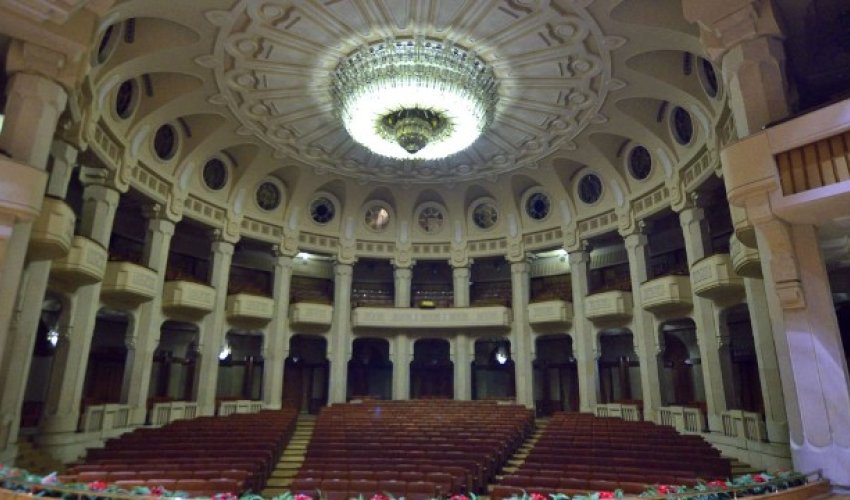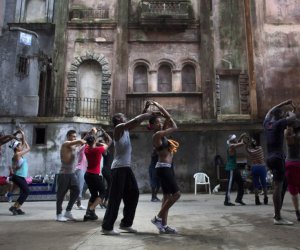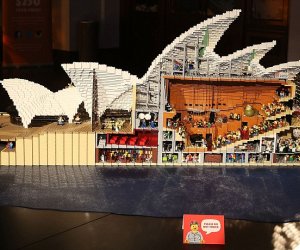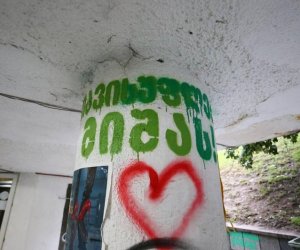Palace of the damned dictator

In late 1989 the carefully constructed edifice of communism in Eastern Europe started crumbling in a wave of popular upheavals with a speed that took everyone by surprise.
Nowhere was this process bolder and bloodier that in the final act of the revolutionary domino: the downfall of Ceausescu, the Romanian dictator who ran his country for the benefit of himself and his family like a feudal master.
Today, the country is still trying to cope with a legacy that defiled the face of Bucharest, bankrupted the state and traumatized generations of Romanians.
For some, one way of overcoming their psychological damage is to tell their story to tourists.
It's now possible to join a tour in Bucharest that awakens the memories from a despised era to recount the story of the last days of Romanian communism.
Monument to megalomania
The tour starts at the grandiose Parliamentary Palace, a permanent reminder of the communist leader's megalomania.
Irene, 30, a chic parliamentary aide, gives us the figures and numbers.
The building, she says, is the world's third largest by volume after the Aztec pyramid of Teotihuacan and the Cape Canaveral rocket assembly hangar.
It uses 220,000 square meters of carpet, 3,500 tons of crystal and one million cubic meters of marble.
The carpet in the main Union Hall alone weighs 1.5 tons.
How did this monster come to be?
Irene tells us how Ceausescu took advantage of a 1977 earthquake to raze most of the lower city center of Bucharest, flattening a hill and changing the course of the Dambovita river.
Forty thousand people were forcibly displaced.
"Everything within an area of four square miles was rebuilt from scratch to match the style of the People's Palace. A stadium, several hospitals and two dozen churches or synagogues were demolished," says Irene.
"Only three historic Orthodox churches were saved by moving them, foundations and all, behind large apartment blocks so that they would remain invisible and not spoil his view."
Perfect echo
Construction involved 700 architects and 20,000 building workers doing three shifts a day, plus 5,000 army personnel, 1.5 million factory workers and an army of so-called volunteers.
The palace's Union Hall features two large spiral staircases that descend to the main entrance to allow Ceausescu and his wife Elena to make grand, synchronized entrances.
"He was short and touchy about his height", says Irene, "so he had the staircases rebuilt twice in order to match his step."
Irene claps her hands. The sound travels crisply.
"Every chamber has a perfect echo, because when Ceausescu wanted something, he clapped. And he wanted everyone to know he'd clapped."
Ceausescu never got to see the building finished.
By the time of the revolution, in December 1989, the building was only two-thirds complete. The incoming administration didn't know what to do with it, but the Romanian economy was so entangled with the palace that it had to be finished.
The building was completed in 1994 and, since 1996, it has housed the Romanian Senate and Chamber of Deputies.
The ground floor is home to a modern art museum.
Nevertheless, the building, which costs a dizzying $6 million a year to run, is still 70% empty.
After one hour of walking up and down its corridors, I had still only seen less than 10% of it.
(CNN)

Nowhere was this process bolder and bloodier that in the final act of the revolutionary domino: the downfall of Ceausescu, the Romanian dictator who ran his country for the benefit of himself and his family like a feudal master.
Today, the country is still trying to cope with a legacy that defiled the face of Bucharest, bankrupted the state and traumatized generations of Romanians.
For some, one way of overcoming their psychological damage is to tell their story to tourists.
It's now possible to join a tour in Bucharest that awakens the memories from a despised era to recount the story of the last days of Romanian communism.
Monument to megalomania
The tour starts at the grandiose Parliamentary Palace, a permanent reminder of the communist leader's megalomania.
Irene, 30, a chic parliamentary aide, gives us the figures and numbers.
The building, she says, is the world's third largest by volume after the Aztec pyramid of Teotihuacan and the Cape Canaveral rocket assembly hangar.
It uses 220,000 square meters of carpet, 3,500 tons of crystal and one million cubic meters of marble.
The carpet in the main Union Hall alone weighs 1.5 tons.
How did this monster come to be?
Irene tells us how Ceausescu took advantage of a 1977 earthquake to raze most of the lower city center of Bucharest, flattening a hill and changing the course of the Dambovita river.
Forty thousand people were forcibly displaced.
"Everything within an area of four square miles was rebuilt from scratch to match the style of the People's Palace. A stadium, several hospitals and two dozen churches or synagogues were demolished," says Irene.
"Only three historic Orthodox churches were saved by moving them, foundations and all, behind large apartment blocks so that they would remain invisible and not spoil his view."
Perfect echo
Construction involved 700 architects and 20,000 building workers doing three shifts a day, plus 5,000 army personnel, 1.5 million factory workers and an army of so-called volunteers.
The palace's Union Hall features two large spiral staircases that descend to the main entrance to allow Ceausescu and his wife Elena to make grand, synchronized entrances.
"He was short and touchy about his height", says Irene, "so he had the staircases rebuilt twice in order to match his step."
Irene claps her hands. The sound travels crisply.
"Every chamber has a perfect echo, because when Ceausescu wanted something, he clapped. And he wanted everyone to know he'd clapped."
Ceausescu never got to see the building finished.
By the time of the revolution, in December 1989, the building was only two-thirds complete. The incoming administration didn't know what to do with it, but the Romanian economy was so entangled with the palace that it had to be finished.
The building was completed in 1994 and, since 1996, it has housed the Romanian Senate and Chamber of Deputies.
The ground floor is home to a modern art museum.
Nevertheless, the building, which costs a dizzying $6 million a year to run, is still 70% empty.
After one hour of walking up and down its corridors, I had still only seen less than 10% of it.
(CNN)
ANN.Az

Similar news
Similar news




































 Photo
Photo 



 Video
Video 

